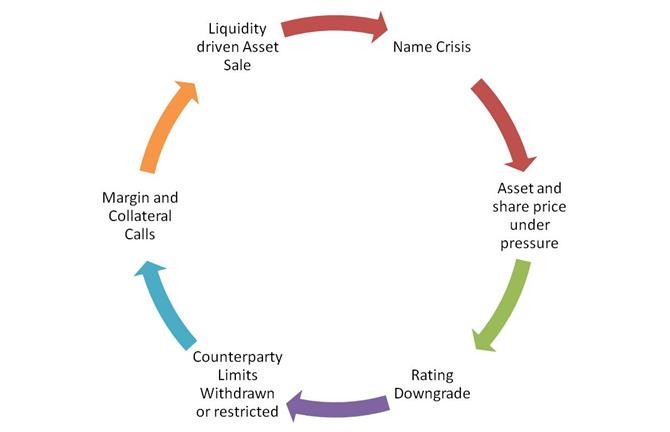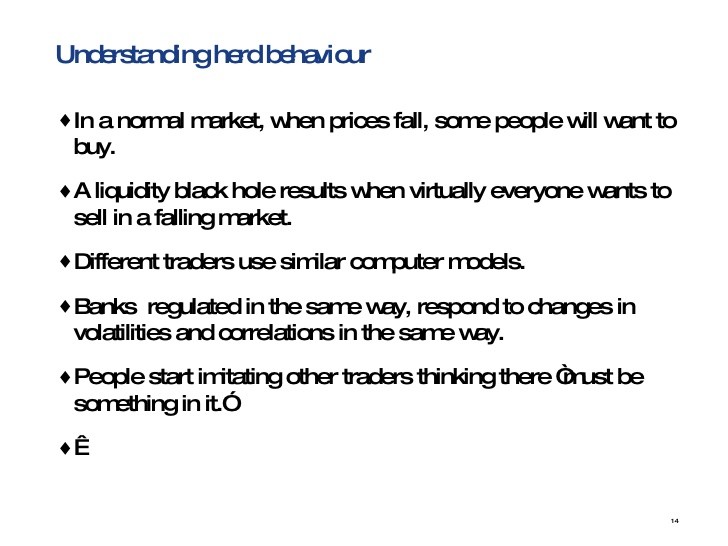Understanding Liquidity Risk
Post on: 30 Июль, 2015 No Comment

Understanding Liquidity Risk
Before the global financial crisis (GFC), liquidity risk was not on everybody’s radar. Financial models routinely omitted liquidity risk. But the GCF has prompted a renewal to understand liquidity risk. One reason is because there was a consensus that the crisis included a run on the shadow (non-depository) banking system — providers of short-term financing, notably in the repo market — systematically withdrew liquidity; they did this indirectly but undeniably by increasing collateral haircuts. After the GFC, all major financial institutions and governments are acutely aware of the risk that liquidity withdrawal can be a nasty accomplice in transmitting shocks through the system (or even exacerbating contagion). (For more on liquidity, check out Understanding Financial Liquidity .)
[b]TUTORIAL: Liquidity Measurement Ratios[/b]
What is liquidity risk?
Liquidity risk is divided into two types: funding liquidity risk (aka cash-flow risk) and market liquidity risk (aka asset/product risk).
Market liquidity risk can be a function of the following:
Note a common feature of both types of liquidity risk: in a sense, they both involve not enough time. Illiquidity is generally a problem that can be solved with more time! (To learn more about risk, read Determining Risk And The Risk Pyramid .)
Figure 1: Measures of Market Liquidity
Measures of Market Liquidity Risk
There are at least three perspectives on market liquidity (see Figure 1). The most popular and crudest measure is the bid-ask spread; this is also called width. A low or narrow bid-ask spread is said to be tight and tends to reflect a more liquid market. Depth refers to the ability of the market to absorb the sale (exit) of a position. An individual investor who sells shares of Google, for example, is not likely to impact the share price; on the other hand, an institutional investor selling a large block of shares in a small capitalization company will probably cause the price to fall. Finally, resiliency refers to the market’s ability to bounce back from temporarily incorrect prices. To summarize:
At one extreme, high market liquidity would be characterized by an owner of a small position relative to a deep market who is exiting into a tight bid-ask spread and a highly resilient market.
What about volume?
Trading volume is a popular measure of liquidity, but it is now considered to be a flawed indicator. High trading volume does not necessarily imply high liquidity. The Flash Crash of May 6, 2010 proved this with painful, concrete examples. In that case, according to the SEC, sell algorithms (program trades) were feeding orders into the system faster than they could be executed. Volume jumped but many backlog orders were not filled. As the SEC wrote, especially in times of significant volatility, high trading volume is not necessarily a reliable indicator of market liquidity. (For more on the flash crash, see Did ETFs Cause The Flash Crash? )
A Common Method for Incorporating Liquidity Risk

In the case of exogenous liquidity risk, one approach is to use the bid-ask spread to directly adjust the metric. Please note: risk models are different than valuation models and this method assumes there are observable bid/ask prices.
Let’s illustrate with value at risk (VaR). Assume the daily volatility of a $1,000,000 position is 1.0%. The position has positive expected return (aka drift), but as our horizon is daily we will bring our tiny daily expected return down to zero (a common practice). So let the expected daily return equal zero. If the returns are normally distributed, then the one-tailed deviate at 5.0% is 1.65; that is, the 5% left tail of normal distribution is 1.65 standard deviations to the left of mean. In excel, we can get this result with =NORM.S.INV(5%) = -1.645.
The 95% value at risk (VaR) is given by:
$1,000,000 * 1.0% volatility * 1.65 = $16,500
Under these assumptions, we can say only 1/20 days (5% of the time) do we expect the daily loss to exceed $16,500. But this does not adjust for liquidity.
Let’s assume the position is in a single stock where the ask price is $20.40 and the bid price is $19.60. In percentage terms the spread (%) = ($20.40 — $19.60)/$20 = 4.0%. The full spread represents the cost of a round trip: buying and selling the stock. But, as we are only interested in the liquidity cost if we need to exit (sell) the position, the liquidity adjustment consists of adding one-half (0.5) the spread. In the case of VaR, we have:
Liquidity cost (LC) = 0.5 * spread
Liquidity-adjusted VaR (LVaR) = position ($) * [-drift (%) + volatility *deviate + LC], or
Liquidity-adjusted VaR (LVaR) = position ($) * [-drift (%) + volatility *deviate + 0.5 * spread],
In our example,
LVaR = $1,000,000 * [-0% + 1.0% * 1.65 + 0.5 * 4.0%] = $36,500
In this way, the liquidity adjustment increases the VaR by one-half the spread ($1,000,000 * 2% = +$20,000).
The Bottom Line
Liquidity risk can be parsed into funding (cash-flow) or market (asset) liquidity risk. Funding liquidity tends to manifest as a credit risk: inability to fund liabilities produces defaults. Market liquidity risk manifests as market risk: inability to sell an asset drives its market price down, or worse, renders the market price indecipherable.
Market liquidity risk is a problem created by the interaction of the seller and buyers in the marketplace. If the seller’s position is large relative to the market, this is called endogenous liquidity risk (a feature of the seller). If the marketplace has withdrawn buyers, this is called exogenous liquidity risk (a characteristic of the market which is a collection of buyers); a typical indicator here is an abnormally wide bid-ask spread.
A common way to include market liquidity risk in a financial risk model (not necessarily a valuation model) is to adjust or penalize the measure by adding/subtracting one-half the bid-ask spread. (For more on Value at Risk, see An Introduction To Value at Risk (VAR) .)














